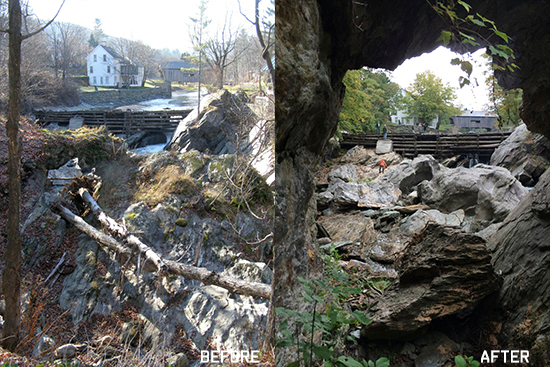
By Rachel Goff
Science, aesthetics, history and community all converged in a discussion on Tuesday, October 14, when the Warren Select Board met with representatives from the Warren Village Dam Preservation Trust, Friends of the Mad River and adjacent property owners to discuss the future of the timber crib dam.
Once an integral part of the bustling mill town, the 200-year-old timber crib dam has started to disintegrate and, according to the select board, it needs to be either repaired, replaced or removed.
The timber crib dam is currently owned by the Warren Village Dam Preservation Trust, which for the past several years has tried—to no avail—to obtain a stream alteration permit from the Agency of Natural Resources (ANR) to repair it. In July of 2013, Mac Rood told the select board the trust was giving up trying, and he offered the town the easement for the dam. The select board declined the offer due to its inherent liability and instead started investigating what it would take to remove the dam from the river entirely.
Meanwhile, the Warren Village Dam Preservation Trust renewed its efforts to repair the structure and harness its hydroelectric potential under the leadership of Dave Sellers. The timber crib dam, Sellers explained last Tuesday, is on the National Register of Historic Places, he said, and because of its past significance, "we have a right to maintain it," he said. "Ninety percent of the buildings that are here right now all had to do with the people who worked at these mills," he said of Warren Village.
Indeed, many who attended Tuesday's meeting spoke of the role the timber crib dam has played in the community over the past two centuries, serving as an iconic image for the town and appearing in countless publications and postcards. "It would break my heart to have it go," one resident said.
"I couldn't agree more with the emotional impact of the dam," select board member Matt Groom said. Groom grew up next to the dam and spent his childhood swimming in the mill pond, "so it's not a heartless, corporate insurance position I'm taking," he said, before stating that he's concerned about the timber crib's safety.
According to Groom, there's a sinkhole above the dam that has formed as parts of it have started to disappear downstream. The sinkhole "isn't obvious," he said, and children often play unknowingly in its vicinity.
"We took a close look at that sinkhole and we agree there needs to be some protection," Sellers agreed. Because the dam is made of wood and not concrete, "it requires some regular maintenance every year or so," Sellers said, but Groom said he feels the dam has disintegrated more than the trust realizes.
"I think your representation of the maintenance needed is inaccurate," Groom said, explaining that he feels the structure is past the point of repair. "It needs to be replaced," he said, "and everything I've ever heard is 'no, this can't be replaced,'" he said, "because the state won't let us."
Currently any and all work that's done in a river in the state of Vermont must be approved by the Vermont Agency of Natural Resources (ANR), "and as we've learned more about flooding and the science of rivers, we've learned they should go back to their natural state," select board member Bob Ackland said.
While the ANR is not necessarily looking to remove the timber crib dam, "I think [their] position is that it's going to come out over time," Friends of the Mad River executive director Corrie Miller explained.
From a scientific standpoint, "the dam is a fluvial, geomorphological challenge," Miller said. In other words, having the structure in the river creates flooding upstream and erosion downstream, "and that's something the town should be aware of," she said.
On the other hand, "what if we found out that taking out the dam undermined the velocity of the water just upstream from it," Ellen Strauss of the Warren Village Dam Preservation Trust said, speaking to its impact on surrounding structures. "After [the dam] was built, all the houses upstream were built," she said.
The Warren covered bridge, which also lies upstream of the timber crib dam, is slated for repairs, and "we wanted to understand, before we put money into the covered bridge, whether or not the dam is going to be there," Ackland said.
The town does not own the dam and, therefore, cannot make the decision as to what to do with it, "but we have an interest in having a safe situation in the middle of the village," select board chair Andy Cunningham said, explaining the select board's reason for facilitating Tuesday's discussion.
The safety of the timber crib dam is important to the select board, because "we live—like it or not—in a litigious society," Warren Conservation Commission chair Damon Reed said. If someone were to get hurt because of the dam and tried to sue, he or she would turn to the town because the trust has no money, and "we'll all feel that," Reed said.
The timber crib dam cannot be allowed to continue to disintegrate, most people in the room last Tuesday agreed. But if it is to be repaired, replaced or removed, "I think the only way we're going to get through the ANR [permitting process] is to go from the top," Groom said, referring to ANR secretary Deb Markowitz.
Earlier in the evening, Sellers indicated that Markowitz appeared susceptible to sitting down and talking with the Warren Village Dam Preservation Trust about its options. "I think this is a major breakthrough," Sellers said, and the select board agreed.
With regard to the timber crib dam, "I think it's important to get the right people around the table," Groom said. Moving forward, the trust will set up a meeting with Markowitz, the town and others who are invested in the future of the historic structure.
{loadnavigation}





